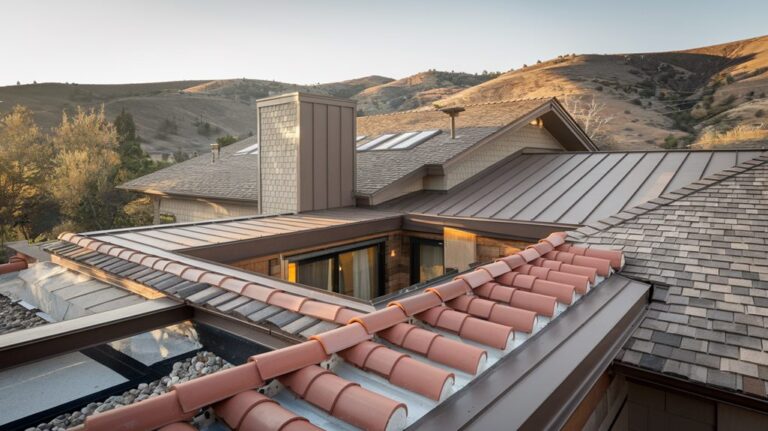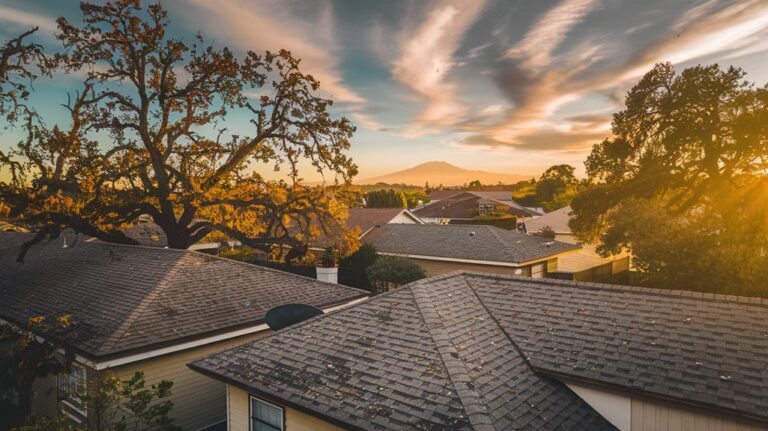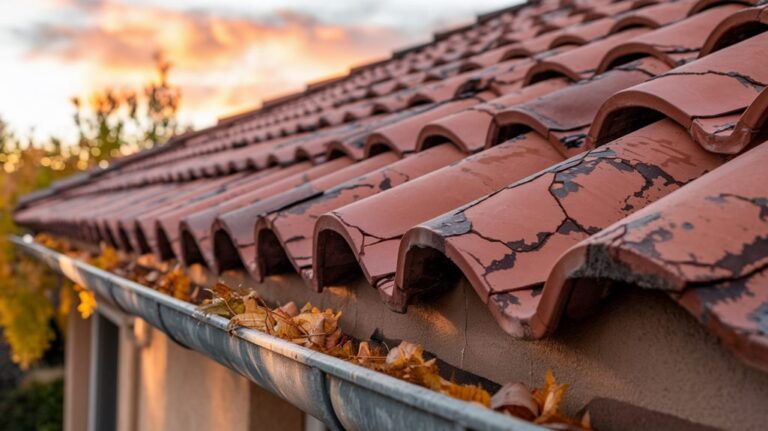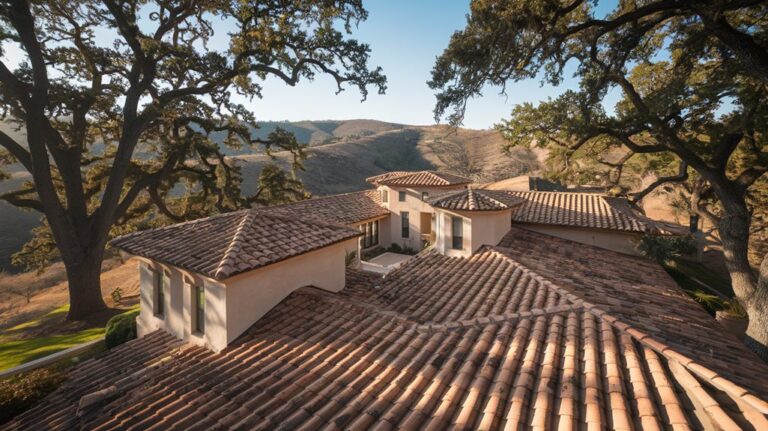Regular maintenance can extend your Walnut Creek roof's lifespan by up to 50% while protecting your home from seasonal rainfall and intense summer heat. Your roof faces unique climate challenges that make proper care essential. Through bi-annual professional inspections, you'll catch minor issues before they become major problems, potentially saving thousands in repair costs. Monthly visual checks and quarterly gutter cleaning help prevent water damage, which poses the greatest threat to your roof's integrity. By maintaining detailed service records, you'll protect your warranty coverage and home value. Discover how proper roof care creates lasting protection for your biggest investment.
Your Roof's First Priority
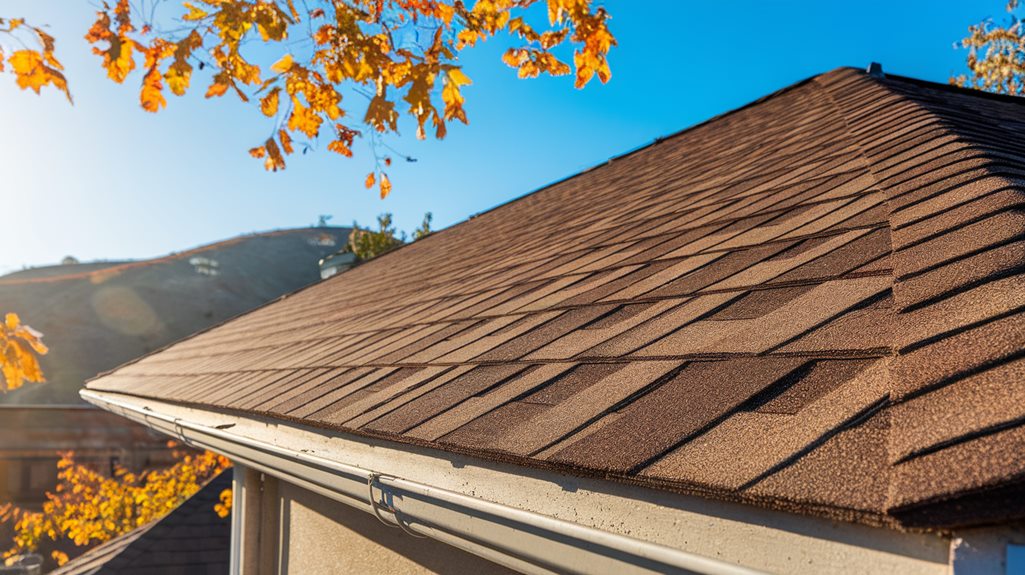
During each season, water poses the greatest threat to your roof's integrity. Whether it's rain, snow, or moisture from foggy Bay Area mornings, water can seep into tiny cracks and gradually compromise your roofing materials. In Walnut Creek's variable climate, these water-related issues become even more essential during the rainy season from November through April.
Your roof's primary defense against water damage lies in its drainage system. You'll need to keep your gutters and downspouts clear of debris, especially after fall when leaves and twigs accumulate. Check for proper water flow during light rain, and make sure there's no standing water on your roof's surface. If you notice water pooling, it's likely due to improper drainage or sagging areas that need immediate attention.
Don't overlook your roof's flashings – those metal strips around chimneys, vents, and joints. They're vital in preventing water from entering vulnerable areas. When these components fail, water can penetrate your roof's underlayment and eventually reach your attic. Regular inspection of these elements, particularly after strong storms, will help you identify potential problems before they lead to costly repairs.
Leaks Cost Homeowners Millions Annually
America's homeowners face staggering costs from roof leaks, with annual repair expenses exceeding $400 million nationwide. In Walnut Creek, you'll find that even minor leaks can quickly escalate into major structural problems, leading to expensive repairs that could've been prevented through regular maintenance.
When water penetrates your roof's protective barriers, it doesn't just damage your shingles – it can destroy insulation, compromise wooden supports, and create perfect conditions for toxic mold growth. You're looking at potential repair costs ranging from $1,000 for minor fixes to $30,000 or more for extensive structural damage.
Don't wait until you spot water stains on your ceiling. By then, the damage has already spread beyond the visible areas. You'll save significant money by scheduling bi-annual inspections that typically cost between $200 and $400. During these checks, professionals can identify early warning signs like cracked shingles, damaged flashing, or clogged gutters before they turn into leaks. They'll also verify that your roof's drainage systems are working properly, ensuring water flows away from your home's foundation. This preventive approach costs just a fraction of what you'd spend on major repairs.
Regular Roof Care Matters

Your roof's protection requires year-round watchfulness, not just occasional attention during storm seasons. By establishing a regular maintenance schedule, you'll prevent minor issues from becoming major repairs and extend your roof's lifespan significantly.
Start with monthly visual inspections from the ground, looking for missing shingles, damaged flashing, or visible wear. You'll want to check your gutters every three months to guarantee proper drainage and prevent water damage. In Walnut Creek's climate, leaves and debris can accumulate quickly, so don't skip this important step.
Schedule professional inspections twice yearly – typically in spring and fall. Your roofer will spot potential problems you can't see from the ground, like weakened seals around vents or early signs of water damage. They'll also check your attic's ventilation, which is vital for preventing moisture buildup and prolonging shingle life.
Keep records of all inspections and repairs. You'll need this documentation for warranty purposes and future maintenance planning. When you maintain your roof consistently, you're not just protecting your home – you're also preserving your property value and avoiding costly sudden repairs.
Declining Property Values Hurt Homeowners
Poor roof maintenance directly impacts property values in Walnut Creek's competitive housing market. When you neglect your roof's upkeep, you're risking more than just structural integrity – you're potentially losing thousands in home equity. Local real estate experts confirm that visible roof damage or deterioration can reduce a home's value by 10-15%.
You'll face immediate challenges when trying to sell a home with a neglected roof. Prospective buyers and their home inspectors will quickly spot issues like missing shingles, water stains, or sagging sections. These red flags often lead to lower offers or drive buyers away completely. Even if you're not planning to sell soon, your property's declining value can affect your ability to refinance or secure home equity loans.
Insurance companies may also increase your premiums or deny coverage when they discover poor roof maintenance. In Walnut Creek's microclimate, where winter rains and summer heat stress roofing materials, maintaining your roof becomes even more critical. You can protect your investment by scheduling regular inspections, addressing repairs promptly, and keeping detailed maintenance records that demonstrate responsible homeownership.
Higher Resale Property Values
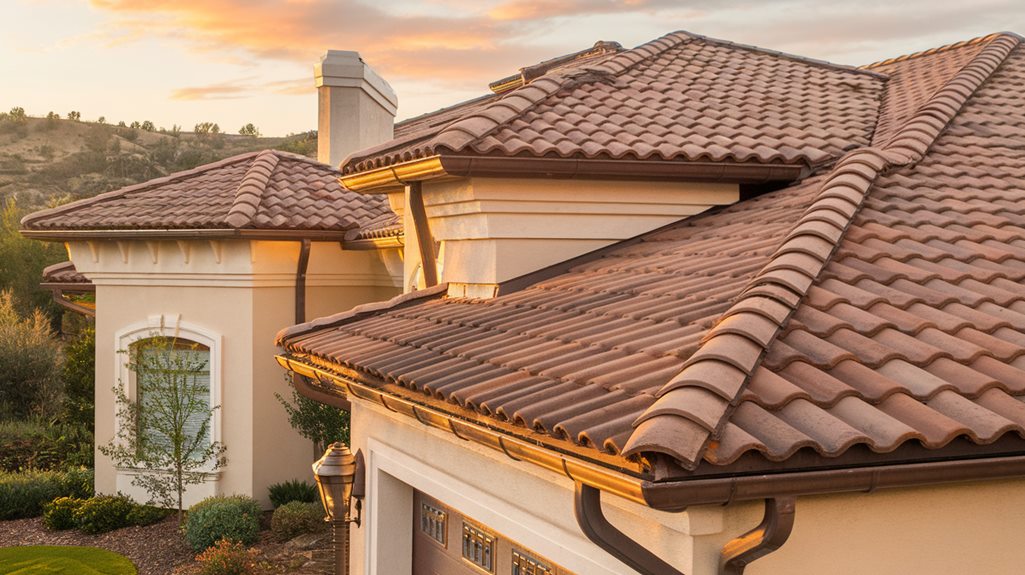
Well-maintained roofs stand out as major selling points in Walnut Creek's real estate market. When you invest in regular roof maintenance, you're protecting one of your home's most valuable assets while positioning your property for maximum resale value. Prospective buyers consistently rank roof condition among their top concerns during home inspections, making your maintenance history an essential factor in negotiations.
You'll find that a well-documented maintenance record can increase your home's market value by 3-5%. When buyers see that you've regularly cleaned gutters, replaced damaged shingles, and addressed minor issues promptly, they're more likely to make competitive offers. They know they won't face immediate roof repairs or replacement costs after purchase.
In Walnut Creek's competitive housing market, your maintained roof becomes a significant differentiator. Homes with neglected roofs typically sell for less and stay on the market longer. By contrast, you can expect faster sales and stronger offers when your roof shows clear signs of regular care. Professional inspections and maintenance records provide tangible proof that you've protected your investment, giving buyers confidence in your property's overall condition.
Mediterranean Weather Patterns Govern
The Mediterranean climate in Walnut Creek poses unique challenges for roof maintenance throughout the year. You'll experience hot, dry summers with temperatures often exceeding 90°F, while winters bring cool, wet conditions with annual rainfall averaging 20 inches. This distinct weather pattern means your roof faces significant temperature fluctuations and moisture variations that can impact its integrity.
During summer months, you'll need to watch for UV damage and heat-related issues that can cause shingles to crack or warp. The intense sunlight can break down roofing materials faster than in cooler climates, while sudden temperature drops at night create expansion and contraction stress. In winter, you'll contend with rain that can expose any existing vulnerabilities in your roof's structure.
Your maintenance schedule should align with these seasonal patterns. It's important to inspect your roof before the rainy season begins in late fall and again after winter storms have passed. You'll want to clear gutters of debris, check for loose shingles, and make sure proper drainage to prevent water damage during the wet months. Understanding these weather patterns helps you anticipate and prevent potential roofing issues.
Hot Dry Mediterranean Summers
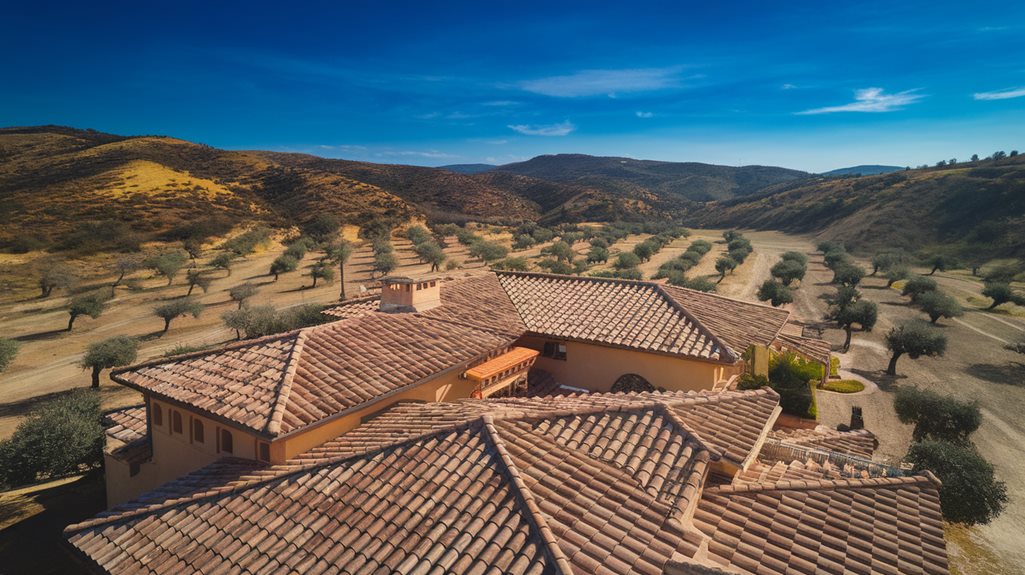
Summer conditions in Walnut Creek significantly impact your roof's durability, with prolonged exposure to intense sunlight and temperatures regularly soaring above 90°F for three to four months. These hot, dry Mediterranean summers can cause substantial wear on your roofing materials through thermal expansion and UV radiation damage.
You'll notice that your roof's materials expand during the day's peak heat and contract during cooler nights. This continuous cycle puts stress on shingles, flashing, and underlying structures. UV rays break down the oils in asphalt shingles, causing them to become brittle and more vulnerable to cracking. Clay tiles can develop hairline fractures, while wooden shakes may split or cup due to moisture loss.
To safeguard your roof during these harsh summer conditions, it's crucial to maintain proper ventilation in your attic space to reduce heat buildup. It is vital to inspect your roof for signs of sun damage, such as curling shingles or cracked tiles, at least twice during the summer season. You should also verify that your roof's protective UV coating hasn't degraded, as this shield helps prevent premature aging of roofing materials.
Spanish Colonial Revival Homes
Spanish Colonial Revival architecture stands out prominently throughout Walnut Creek's historic neighborhoods, featuring distinctive clay tile roofs that require specialized maintenance approaches. You'll need to inspect your clay tiles at least twice yearly, checking for cracked, chipped, or displaced pieces that could jeopardize your roof's integrity.
When maintaining your Spanish Colonial Revival home's roof, you'll want to focus on the unique S-shaped barrel tiles, ensuring proper overlap and alignment. These tiles can shift during seismic activity or strong winds, so you'll need to secure any loose pieces promptly. Don't forget to clear debris from the channels between tiles, as trapped leaves and twigs can lead to water damage.
You'll also need to maintain the underlayment beneath your clay tiles, which typically needs replacement every 20-25 years, even if the tiles themselves remain intact. If you notice any water stains on your ceiling or walls, don't wait to address them – moisture infiltration can quickly deteriorate your roof's wooden support structure. When repairs are necessary, it's vital to work with contractors who specialize in historic Spanish Colonial Revival homes to maintain your property's architectural authenticity.
Title 24 Roofing Standards
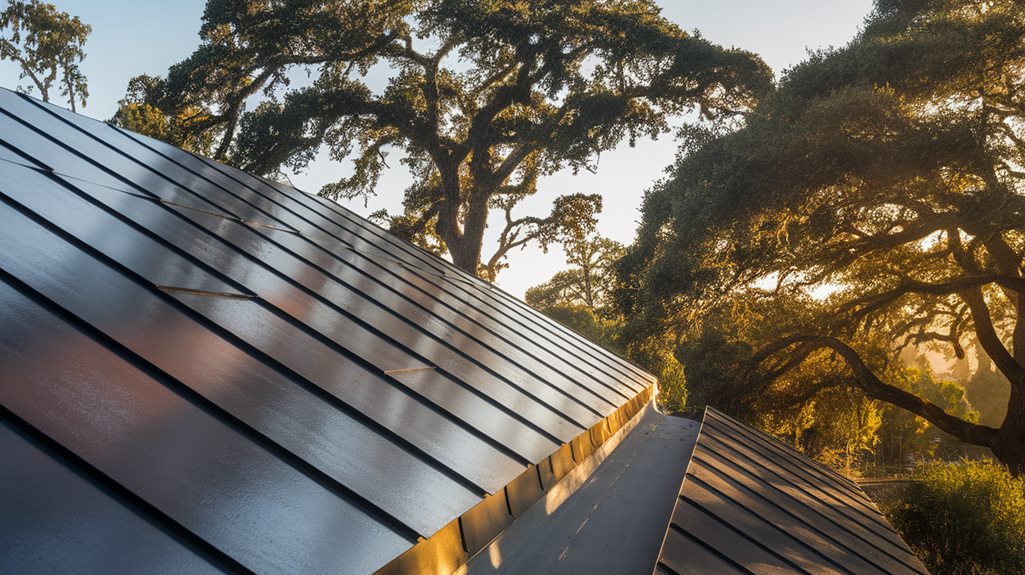
California's Title 24 roofing standards play a significant role in your home's energy efficiency requirements. These regulations mandate specific performance criteria for roofing materials, including minimum solar reflectance and thermal emittance values. When you're maintaining or replacing your Walnut Creek roof, you'll need to meet these standards to avoid penalties and maximize energy savings.
You'll find that Title 24 requirements vary based on your roof's slope and the building's type. For low-slope roofs (less than 2:12 pitch), you'll need materials with a minimum solar reflectance of 0.63 and thermal emittance of 0.75. For steep-slope roofs, the requirements are 0.20 and 0.75, respectively. If you're planning a roof replacement, you'll want to choose "cool roof" materials that meet these criteria.
Regular maintenance helps preserve your roof's Title 24 compliance. You'll need to clean your roof periodically to maintain its reflective properties and check for damage that could compromise its energy efficiency. Remember that any modifications or repairs must also adhere to these standards, so it's crucial to collaborate with contractors who comprehend Title 24 requirements for Walnut Creek homes.
Roof Material Selection Guide
Building on Title 24's requirements, selecting the right roofing material for your Walnut Creek home involves several key aspects beyond energy standards. You'll need to take into account the local climate, your home's architectural style, and your budget when making this pivotal decision.
For Mediterranean climates like Walnut Creek's, clay and concrete tiles offer excellent durability and heat resistance. They'll last 50+ years but require stronger structural support due to their weight. Asphalt shingles remain popular for their cost-effectiveness and 20-30 year lifespan, while metal roofing provides superior fire resistance and can last 40-70 years with proper maintenance.
You’ll find cool roofing materials particularly advantageous in Walnut Creek’s warm summers. These include light-colored tiles, specially coated metal panels, and reflective asphalt shingles. For homes with low-slope sections, modified bitumen or TPO (thermoplastic polyolefin) membranes offer reliable waterproofing. By choosing these top roofing materials for Walnut Creek, homeowners can significantly reduce cooling costs while increasing the longevity of their roofs. Additionally, investing in energy-efficient options can contribute to a more sustainable environment, making the community greener. As trends shift towards eco-friendly solutions, incorporating these roofing materials not only enhances aesthetics but also aligns with modern energy conservation practices.
When weighing your options, don't forget to take into account maintenance requirements. While slate and tile demand minimal upkeep, they're more expensive initially. Wood shakes create a natural look but need regular treatment against moisture and insects in Walnut Creek's climate.
Residential Roofing Material Options
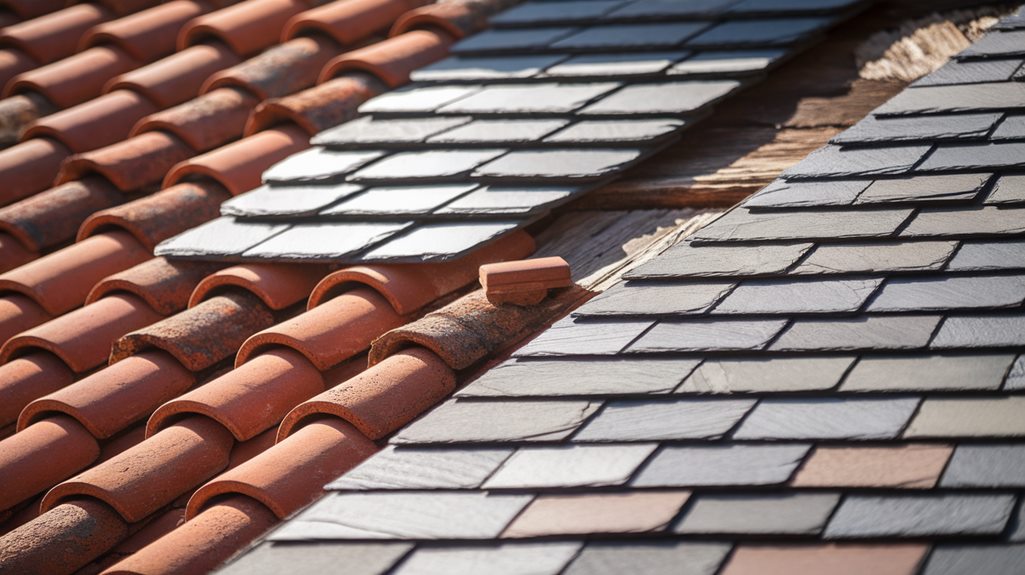
When selecting residential roofing materials in Walnut Creek, you'll discover a diverse range of options that match your home's needs and aesthetic preferences. Asphalt shingles remain the most popular choice due to their affordability, durability, and easy maintenance. They'll typically last 20-30 years and come in various colors and styles.
For a more upscale look, you can choose concrete or clay tiles, which are ideal for Mediterranean or Spanish-style homes common in Walnut Creek. These materials offer excellent durability and can last 50+ years with proper maintenance. Metal roofing provides another long-lasting option, resistant to fire and severe weather conditions while reflecting solar heat.
If you're environmentally conscious, you'll want to bear in mind slate roofing or synthetic materials that mimic natural materials. Slate offers unmatched longevity, often lasting over 100 years, though it's heavier and more expensive. Synthetic options like composite or recycled materials provide durability and sustainability while requiring less maintenance.
Each material has specific maintenance requirements and weight considerations, so you'll need to check that your home's structure can support your chosen material before making a final decision.
Standard Asphalt Shingle Protection
Protection of asphalt shingles starts with understanding their core vulnerabilities in Walnut Creek’s climate. Your roof’s asphalt shingles face intense summer heat, winter rains, and occasional strong winds that can accelerate wear and tear. You’ll need to implement specific protective measures to maximize their lifespan and maintain their effectiveness. Regular inspections are essential to catch any early signs of damage, such as curling or cracking, which can be exacerbated by Walnut Creek’s diverse weather conditions. Additionally, ensuring proper ventilation in your attic can help prevent heat buildup and moisture accumulation, both of which can deteriorate asphalt shingles over time. For more insights on maintaining your roof’s integrity, consider these tips for roof weather protection to safeguard your investment against the elements.
To protect your asphalt shingles effectively, focus on these essential maintenance tasks:
- Clean your gutters quarterly to prevent water backup that can damage shingle edges and cause underlayment rot
- Inspect for loose or missing granules after strong storms, as granule loss reduces UV protection and shortens shingle life
- Remove any overhanging tree branches that could scrape against shingles during windy conditions
- Check for proper attic ventilation to prevent heat buildup that can warp and crack shingles
- Seal any exposed nail heads or loose flashings to prevent water infiltration
You'll want to schedule professional inspections at least once a year, preferably in early fall before the rainy season. Don't wait for visible damage to appear – preventive maintenance costs considerably less than emergency repairs or premature roof replacement.
0-Year Weathering Performance Ratings
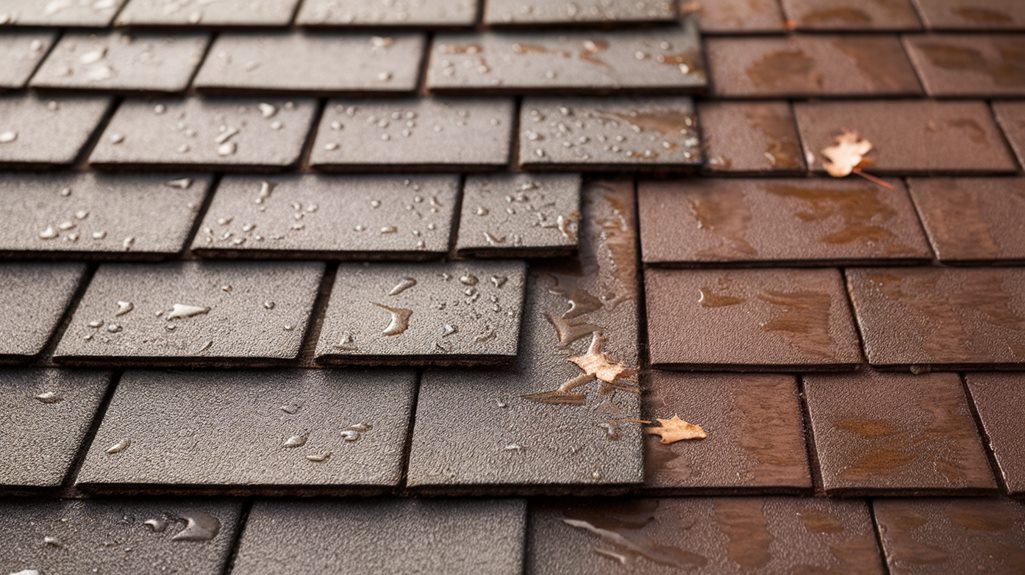
Understanding weathering performance ratings helps you evaluate how well your Walnut Creek roof will hold up over time. These ratings, measured in years, indicate your roofing material's expected resistance to sun exposure, rain, wind, and temperature fluctuations common in the Bay Area climate.
You'll find most asphalt shingles carry ratings between 20 and 30 years, while premium materials like slate or tile can rate up to 50 years. The rating system considers factors like granule loss, thermal cracking, and wind uplift resistance. When you're examining these ratings, you'll want to look for Class A fire ratings and wind ratings of at least 110 mph for Walnut Creek's conditions.
Don't assume the year rating guarantees your roof will last that long without maintenance. These ratings reflect ideal conditions and proper installation. You'll need regular inspections and maintenance to achieve the full lifespan. Check your warranty documentation, as it'll specify the conditions you must meet to maintain coverage. Remember that local factors like overhanging trees, pollution levels, and extreme weather events can considerably impact your roof's actual performance compared to its rating.
Longevity Versus Installation Costs
The financial balance between initial costs and long-term durability shapes your roofing decisions in Walnut Creek. When you're weighing installation expenses against a roof's potential lifespan, you'll need to weigh both immediate budget constraints and future maintenance costs. A higher upfront investment in quality materials and professional installation often translates to extended durability and fewer repairs.
- Premium asphalt shingles cost $8-12 per square foot but last 25-30 years with proper maintenance
- Metal roofing averages $15-20 per square foot and can endure 50+ years in Walnut Creek's climate
- Tile roofs run $20-30 per square foot with a lifespan exceeding 75 years
- Basic asphalt options cost $5-7 per square foot but typically need replacement after 15-20 years
- Cedar shakes fall in the $12-15 range and last 30-35 years with regular treatments
You'll find that spending more initially on materials like metal or tile can reduce your long-term costs by up to 40% when factoring in maintenance and replacement cycles. Take into account your property's value, how long you plan to stay, and your budget to determine the most cost-effective roofing solution for your situation.
8-12 per Square Foot

Within Walnut Creek's roofing market, professional labor costs average $2 per square foot for basic maintenance and inspections. This rate includes essential services like gutter cleaning, shingle inspection, and minor repairs that help prevent costly damage. You'll find this price point particularly reasonable when compared to the expenses of major repairs or full roof replacement.
When you calculate the total cost for your home, simply multiply your roof's square footage by $2. For example, if you've got a 2,000-square-foot roof, you're looking at approximately $4,000 for annual maintenance. While this might seem significant, it's a fraction of what you'd pay for emergency repairs or premature replacement.
The $2 per square foot rate typically covers two annual inspections, which you'll want to schedule in spring and fall. During these visits, professionals will check for loose shingles, inspect flashing around chimneys and vents, clear debris, and identify potential problem areas. They'll also examine your attic's ventilation and look for signs of water damage or mold growth. By investing in this regular maintenance, you're effectively doubling or tripling your roof's lifespan.
Clay Spanish Roofing Tiles
Clay Spanish roofing tiles remain a popular choice among Walnut Creek homeowners because they perfectly complement Mediterranean and Spanish Colonial architecture while providing exceptional durability. When properly maintained, these tiles can last 75-100 years, making them one of the most long-lasting roofing materials available.
You'll need to inspect your clay tile roof regularly and watch for these critical issues:
- Cracked or broken tiles that can allow water to penetrate and damage your roof's underlayment
- Displaced tiles that have shifted due to strong winds or natural settling
- Accumulation of debris in the valleys and gutters, which can trap moisture
- Deteriorating underlayment, especially in areas where tiles meet flashing
- Loose or missing mortar at the ridge caps and hip joints
If you notice any of these problems, don't wait to address them. Walking on clay tiles requires special techniques to avoid breakage, so it's best to hire a professional roofer who's experienced with Spanish tile systems. They'll use proper safety equipment and walking boards to distribute weight evenly while performing inspections or repairs.
Slope Adaptability for Clay
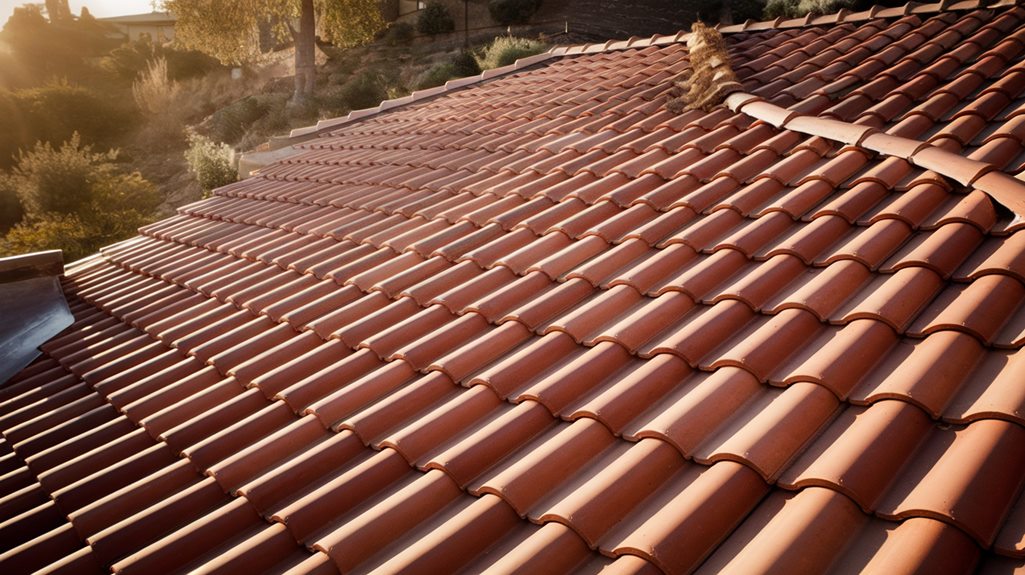
Understanding slope requirements becomes highly relevant when pondering over clay tile installations for your Walnut Creek home. Clay tiles require specific roof pitches to ensure proper water drainage and prevent moisture-related issues. You'll need a minimum slope of 4:12 (a rise of 4 inches for every 12 inches of horizontal run) for most clay tile installations.
If you're planning to install clay tiles on steeper slopes, you'll need additional fastening methods to secure them properly. For slopes exceeding 6:12, you should use mechanical fasteners and additional adhesive to prevent tiles from sliding. On slopes greater than 12:12, you'll require specially designed installation systems and expert consultation to ensure safety and functionality.
For lower slopes between 2.5:12 and 4:12, you can still use clay tiles, but you'll need additional waterproofing measures. This includes installing enhanced underlayment and implementing special flashing details. However, if your roof's pitch falls below 2.5:12, clay tiles aren't recommended, as they won't provide adequate water shedding. In such cases, you'll want to ponder over alternative roofing materials that better suit low-slope applications.
Weather-Resistant Clay Durability
Throughout the seasons in Walnut Creek, weather-resistant clay tiles demonstrate their exceptional durability against harsh environmental conditions. You'll notice that these tiles uphold their structural integrity and appearance even when exposed to intense sunlight, heavy rains, and occasional frost. Their natural composition enables them to endure temperature fluctuations without cracking or warping.
Clay tiles offer remarkable weather resistance due to these key features:
- Dense molecular structure that inhibits water absorption
- Natural thermal properties that regulate roof temperature
- High-temperature firing process that establishes a lasting weatherproof barrier
- Color-fast properties that won't diminish under UV exposure
- Superior impact resistance against hail and falling debris
You can anticipate your clay tile roof to uphold its protective qualities for 50-100 years when properly maintained. The tiles' weather resistance actually enhances over time as the material continues to harden through natural aging processes. To optimize this durability, you'll need to schedule regular inspections and promptly address any minor repairs. Keep the tiles clean of debris and ensure proper drainage to prevent water accumulation, which helps maintain their weather-resistant characteristics throughout their lifespan.
15,000 Average Roof Replacement

While weather-resistant materials offer impressive longevity, your Walnut Creek roof will eventually need replacement. In Walnut Creek's climate, you can expect an asphalt shingle roof to last 20-25 years, while clay tile roofs often endure 50-100 years with proper maintenance. Metal roofs typically last 40-70 years, depending on the specific material and installation quality.
You'll need to budget accordingly for replacement costs, which vary significantly based on your roof's size and material choice. Currently, asphalt shingle replacement averages $15,000-$25,000 for a typical Walnut Creek home, while clay tile installations can range from $25,000-$45,000. Metal roof replacements often fall between $20,000-$40,000.
To determine if you're approaching replacement time, watch for these warning signs: widespread shingle curling, missing granules, daylight visible through roof boards, or sagging sections. You'll also want to check your installation records, as warranties typically expire when your roof reaches the end of its expected lifespan. Don't wait until you notice water damage – schedule an inspection when your roof approaches the final years of its projected durability.
Valley Flashing Deterioration Issues
Roof valleys, where two roof planes intersect, face significant wear due to their role in channeling water runoff. You'll need to pay special attention to these critical areas since they handle high volumes of water during storms and are prone to deterioration over time. Valley flashing, the metal material that protects these intersections, can develop issues that compromise your roof's integrity.
Watch for these warning signs of valley flashing problems:
- Rust spots or corrosion on the metal flashing
- Loose or separated flashing sections that have pulled away from the roof
- Missing or damaged sealant around the valley edges
- Water stains on your ceiling directly below roof valleys
- Granules from shingles accumulating in the valleys
When you spot these issues, don't wait to address them. Valley flashing problems can quickly lead to serious leaks and structural damage. You'll want to schedule an inspection if you notice any of these signs, especially if your roof is over 10 years old. Regular maintenance of your valley flashing, including cleaning debris and checking seals, will help prevent costly repairs and extend your roof's lifespan.
Clogged Gutter Drainage Issues
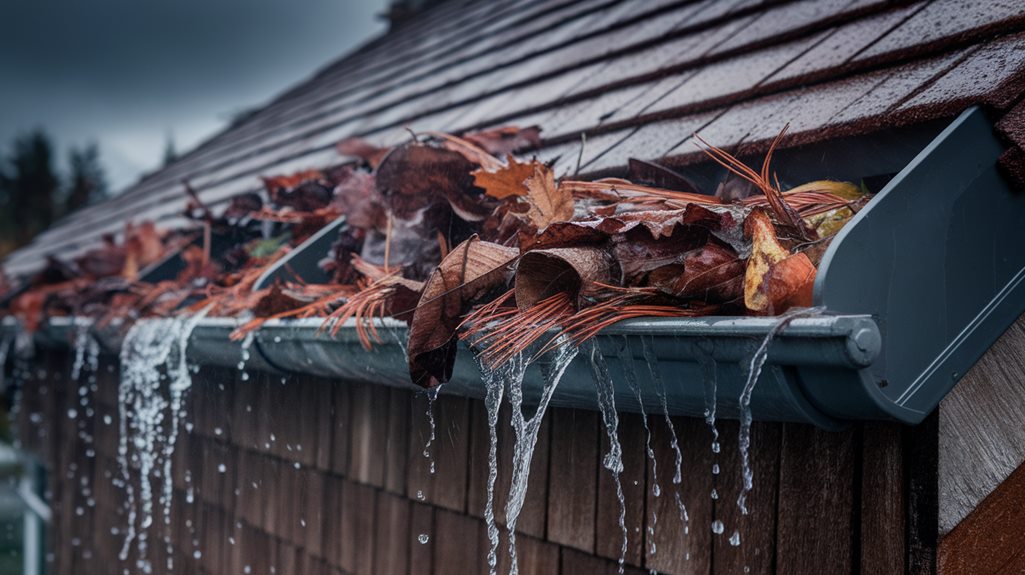
Proper water drainage doesn't stop at valley maintenance – your gutters play a major role in safeguarding your Walnut Creek home from water damage. When gutters become clogged with leaves, twigs, and debris, they can't efficiently channel water away from your roof and foundation. This backup creates standing water that can seep under shingles and cause extensive damage to your roofing system.
You'll notice several warning signs when your gutters aren't functioning properly. Water spilling over the sides, sagging sections, and visible plant growth indicate it's time for immediate cleaning. During Walnut Creek's rainy season, clogged gutters can lead to ice dams, roof leaks, and foundation problems that'll cost thousands to repair.
To prevent these issues, you should clean your gutters at least twice a year – more frequently if you have overhanging trees. Install gutter guards to reduce debris accumulation, and verify your downspouts extend far enough from your home's foundation. Regular inspections will help you spot potential problems before they escalate. Don't forget to check for loose fasteners, separation from the fascia, and proper slope to maintain effective drainage.
Intense UV Ray Exposure
Blazing California sunshine batters Walnut Creek roofs year-round, making UV protection a crucial maintenance concern. The sun's ultraviolet rays gradually break down your roofing materials, causing them to become brittle, fade, and deteriorate faster than they should. You'll notice this damage first on the south and west-facing sections of your roof, where UV exposure is most intense.
To protect your roof from harmful UV radiation, you'll need to take proactive steps:
- Schedule annual inspections to catch UV-related deterioration early, especially on sun-exposed slopes
- Apply UV-resistant roof coatings or treatments every 3-5 years to maintain protection
- Install proper attic ventilation to reduce heat buildup that compounds UV damage
- Consider UV-reflective shingles or cool roofing materials during your next replacement
- Remove debris regularly to prevent surface abrasion that can wear down UV-protective layers
Don't wait until you see visible sun damage to act. UV ray exposure is a silent destroyer that works continuously on your roof's surface. By implementing these protective measures, you'll significantly prolong your roof's lifespan and maintain its structural integrity against Walnut Creek's intense sunshine.
Seal Visible Membrane Cracks
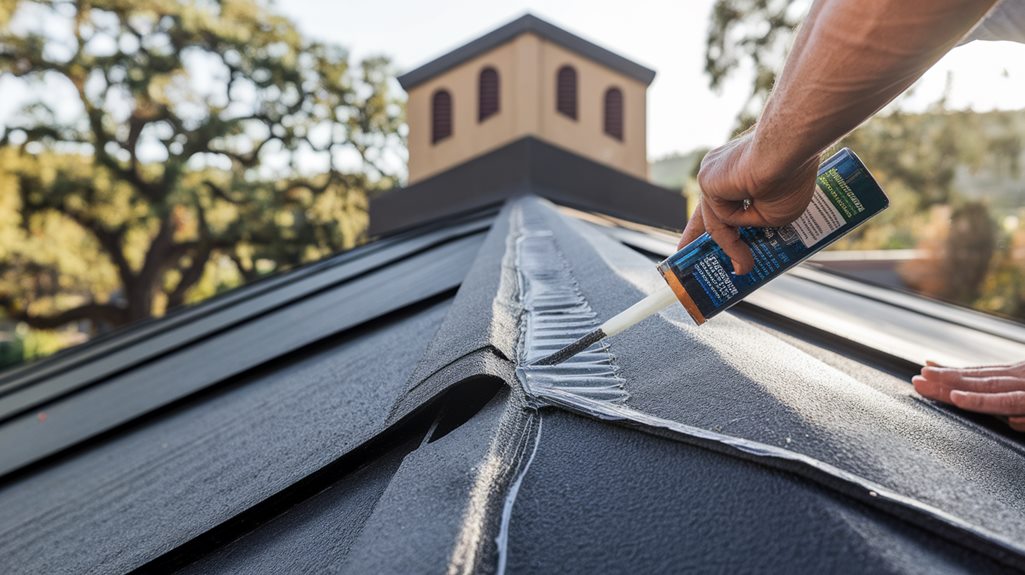
Keeping up with membrane cracks should top your Walnut Creek roof maintenance checklist. These small fissures can quickly escalate into major leaks if you don't address them promptly. You'll need to inspect your roof's membrane regularly, especially after severe weather events or temperature fluctuations that can cause the material to expand and contract.
When you spot a crack, don't wait to seal it. Start by thoroughly cleaning the affected area with a mild detergent and water solution, then let it dry completely. You'll want to use a high-quality roof sealant that's compatible with your specific membrane material. Apply the sealant generously, extending it at least two inches beyond the crack's edges to [guarantee] proper coverage and adhesion.
If you're dealing with multiple cracks or aren't confident in your repair skills, it's best to call a professional roofing contractor. They'll have access to commercial-grade sealants and can spot potential problems you might miss. Remember, proper sealing doesn't just prevent water infiltration—it also protects your roof's structural integrity and helps maintain your home's energy efficiency throughout Walnut Creek's varying seasons.
Broken Ridge Tile Issues
The integrity of your ridge tiles forms an essential defensive line against Walnut Creek's weather elements. When these tiles crack or break, they leave your roof vulnerable to water penetration, pest intrusion, and structural damage. You'll need to address broken ridge tiles promptly to prevent escalating issues that could compromise your entire roofing system.
Your ridge tiles require immediate attention if you notice any of these warning signs:
- Visible cracks or chips along the ridge line
- Missing mortar between ridge tiles
- Shifted or loose ridge caps that don't align properly
- Water stains on your ceiling near the roof's peak
- Daylight visible through your attic ridge area
Don't wait until the rainy season hits to fix broken ridge tiles. You'll want to schedule repairs during dry weather when crews can safely access your roof and properly seal new tiles. While it's tempting to attempt DIY repairs, working at your roof's highest point carries significant risks. Professional roofers have the proper safety equipment and expertise to replace broken ridge tiles while ensuring proper overlap and water-tight seals that protect your home's structural integrity.
Persistent Winter Fog Damage
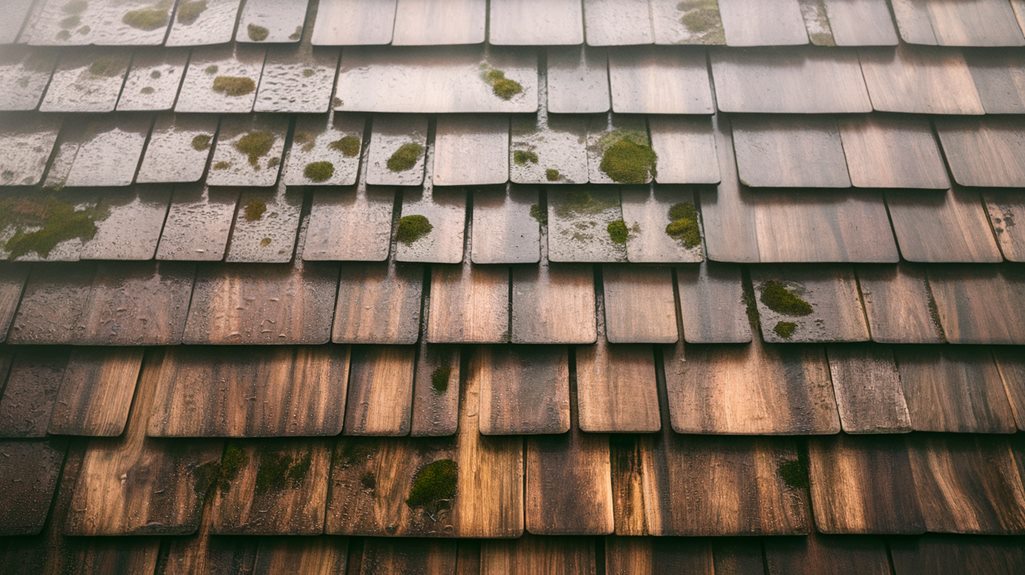
Walnut Creek's notorious winter fog blankets roofs for extended periods, creating ideal conditions for moisture damage, mold growth, and material deterioration. You'll notice this persistent fog can linger for days, allowing moisture to seep into tiny cracks and crevices of your roofing materials.
When fog settles on your roof, it doesn't evaporate quickly like rain. Instead, it creates a sustained dampness that can compromise your shingles, underlayment, and wooden structures. You'll need to watch for early warning signs, such as dark spots on your ceiling, musty odors in your attic, or visible moss formation on roof surfaces.
To combat fog-related damage, you should make sure your attic ventilation system works properly and maintains consistent airflow. It's essential to schedule regular inspections during winter months to catch potential issues before they worsen. You'll want to clear your gutters frequently, as fog-related moisture can cause debris to clump and block proper drainage. Additionally, you should treat your roof with anti-fungal solutions specifically designed for the Bay Area's unique climate conditions. Consider installing moisture sensors in your attic to monitor humidity levels and prevent extensive damage.
Silicone-Based Waterproof Sealant Application
Durability demands proper silicone-based sealant application for Walnut Creek roofs, especially around vulnerable areas like flashings, vents, and skylights. You'll need to carefully inspect these areas and apply high-quality silicone sealant to prevent water intrusion and extend your roof's lifespan.
Before you begin the application process, make sure the surface is clean, dry, and free from debris. You'll want to choose a premium-grade silicone sealant that's specifically designed for roofing applications, as these products offer superior UV resistance and flexibility in Walnut Creek's varying temperatures.
Key considerations for successful sealant application:
- Clean the application area with a wire brush and appropriate solvent to remove old sealant and guarantee proper adhesion
- Apply masking tape along edges to create clean, professional-looking lines
- Use a caulking gun to apply an even bead of sealant, maintaining consistent pressure
- Tool the sealant within 10 minutes of application to guarantee proper penetration and adhesion
- Allow the sealant to cure for at least 24 hours before exposing it to moisture
Remember to check your sealant applications every six months, as even the highest quality products may require periodic touch-ups to maintain their effectiveness.
Professional Tile Installation Methods
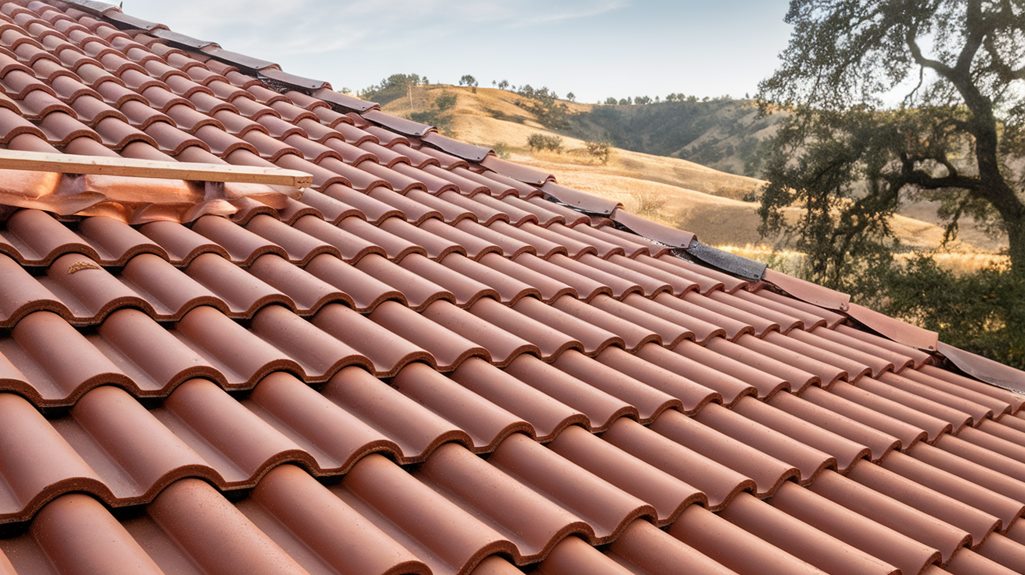
For peak performance in Walnut Creek's climate, professional tile roof installation demands meticulous attention to detail and specific methodologies. You'll need to guarantee proper underlayment installation first, utilizing a high-quality synthetic material that's secured with corrosion-resistant fasteners. The battens must be aligned perfectly to maintain straight coursing and proper water drainage.
When you're installing concrete or clay tiles, you'll need to maintain consistent spacing and overlap between each piece. The headlap should be at least 3 inches to prevent water intrusion, while side laps require precise measurement to guarantee proper watershed. You'll want to secure each tile with copper or stainless steel nails, positioning them correctly to withstand Walnut Creek's occasional high winds.
Don't forget to install proper flashing at all roof penetrations, valleys, and changes. You'll need to use compatible metals and ensure proper integration with the underlayment system. The ridge and hip tiles require secure mounting with a mortar bed or mechanical fastening system, depending on the manufacturer's specifications. Remember to include adequate ventilation gaps at the eaves and ridge to prevent moisture buildup in your attic space.
Licensed Contractor Reviews Matter
While professional installation sets the foundation, regular inspections by licensed contractors serve as your roof's best defense against potential issues. In Walnut Creek's varied climate, you'll want a qualified expert who can spot early warning signs before they become costly repairs. Licensed contractors bring specialized knowledge of local building codes, safety requirements, and region-specific weather challenges.
When you schedule regular reviews with licensed contractors, you'll benefit from:
- Detailed documentation of your roof's condition, including photos and written assessments
- Professional identification of potential problems like loose tiles, damaged flashing, or compromised seals
- Expert recommendations for preventive maintenance based on your roof's age and materials
- Compliance verification with manufacturer warranties and local building regulations
- Cost-effective repair strategies that can extend your roof's lifespan
You shouldn't wait for visible damage to contact a licensed contractor. Annual inspections help maintain your warranty coverage and prevent small issues from escalating into major problems. By working with licensed professionals, you're investing in your home's long-term value and protecting yourself from unauthorized repairs that could void your insurance coverage or result in code violations.
Check Contractor Insurance Coverage
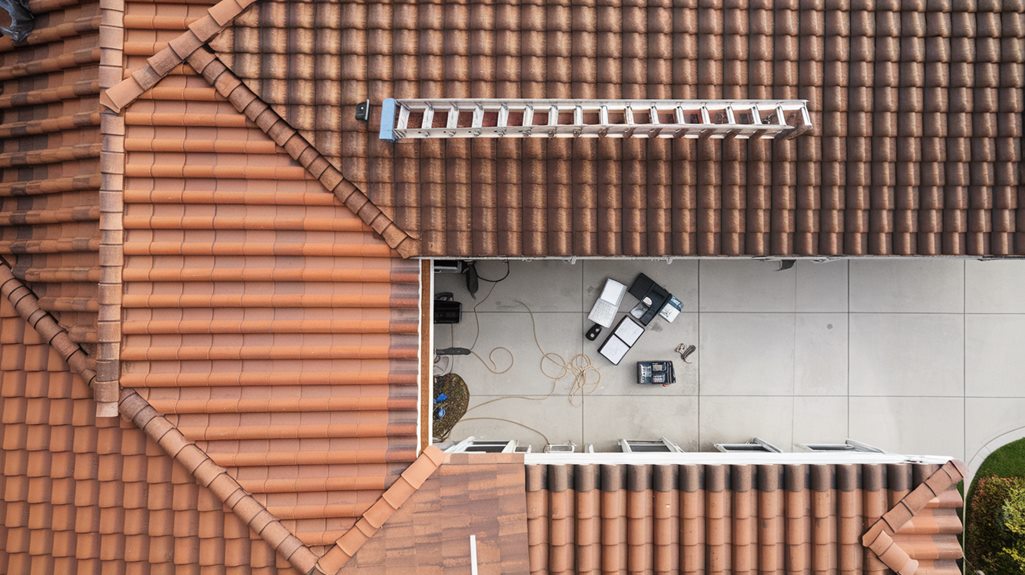
Before hiring any roofing contractor in Walnut Creek, you must validate their insurance coverage to safeguard yourself from liability and financial risks. Ask the contractor to provide current certificates for both workers' compensation and general liability insurance. Don't just take their word for it – contact the insurance company directly to confirm the policies are active and sufficient for your project.
Workers' compensation insurance shields you in case a worker sustains an injury on your property, while general liability coverage protects against potential damage to your home during the maintenance work. Ensure the policy limits are adequate – typically, you'll want to see at least $1 million in general liability coverage.
You'll also need to verify if the insurance covers roofing work specifically, as some contractors may have general construction insurance that excludes roof-related activities. Request to be included as an "additional insured" on their policy for the duration of your project. This additional step guarantees you're informed if the policy lapses or is canceled. Retain copies of all insurance documentation in your records until the maintenance work is complete.
California C-39 Roofing License
Beyond proper insurance coverage, any roofing contractor working in Walnut Creek must hold a valid California C-39 Roofing License. This specialized license guarantees your contractor has met the state's strict requirements for performing roofing work legally and safely in California. You'll want to verify this license before hiring anyone to maintain or repair your roof.
The C-39 license isn't just a piece of paper – it signifies a contractor's commitment to professionalism and expertise. When you're checking a contractor's credentials, you should know what the C-39 license requires:
- Four years of journeyman-level experience in roofing
- Passing both trade and business law examinations
- Background check and fingerprint clearance
- Proof of workers' compensation insurance
- Bond requirements for consumer protection
You can verify a contractor's license status through the Contractors State License Board's website. Don't hesitate to ask potential contractors for their license number and check it yourself. Remember, working with an unlicensed contractor in Walnut Creek isn't just risky – it's illegal and could nullify your homeowner's insurance if something goes wrong during maintenance or repairs.
License/Insurance Verification Process
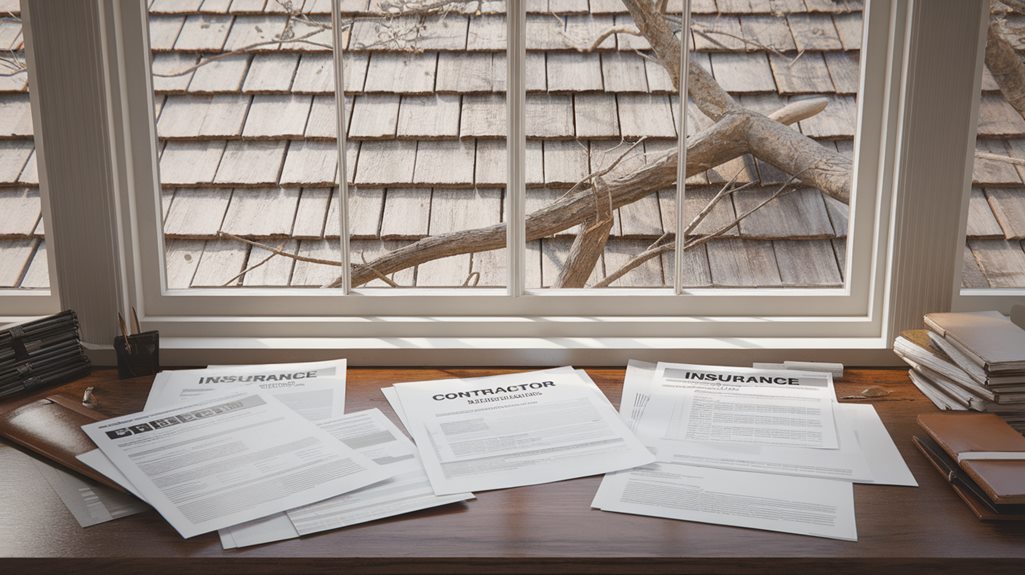
Three essential steps make up the license and insurance verification process for Walnut Creek roofing contractors. First, you'll need to verify the contractor's C-39 license status through California's Contractors State License Board (CSLB) website or by phone. Enter their license number or company name to confirm they're actively licensed and check for any disciplinary actions.
Next, you should request proof of both workers' compensation and general liability insurance. Ask the contractor to provide current certificates of insurance, and contact their insurance carrier directly to verify the policies are active. Make sure the coverage amounts meet California's minimum requirements and haven't lapsed.
Finally, you'll want to confirm their bonding status. California requires licensed contractors to maintain a contractor's bond of $15,000. You can verify this through the CSLB's website as well. Don't skip this step, as the bond protects you if the contractor fails to complete the work or violates state regulations.
Document all verification results and keep copies of insurance certificates, license numbers, and bond information for your records. This documentation proves invaluable if any issues arise during your roofing project.
Checking Yearly Inspection Reports
With proper documentation habits already established for licenses and insurance, yearly inspection reports should be your next priority. These detailed records help you track your roof's condition over time and plan for necessary repairs before they become major issues. You'll want to maintain a digital or physical folder containing all inspection reports, which should include photos, repair recommendations, and cost estimates.
Review your yearly inspection reports for these critical elements:
- Documented evidence of water damage, including stains, mold, or rotting wood
- Condition assessments of shingles, tiles, flashing, and drainage systems
- Measurements of wear patterns and material degradation rates
- Timeline recommendations for repairs or replacements
- Cost projections for upcoming maintenance needs
When you track these reports systematically, you'll notice patterns in your roof's performance and deterioration. You can compare findings from year to year, making it easier to predict when you'll need major repairs or replacements. This proactive approach helps you budget effectively and prevents unexpected roofing emergencies. Don't forget to share these reports with your insurance company, as they often offer reduced premiums for well-maintained roofs with documented inspection histories.
Compare Three Written Estimates

Before deciding on any roofing maintenance work, you'll need to obtain and carefully compare at least three written estimates from reputable Walnut Creek contractors. Make sure each estimate includes detailed information about materials, labor costs, timeline, and specific maintenance tasks to be performed. Don't hesitate to ask questions if any part of the estimate seems unclear or incomplete.
When comparing estimates, look beyond just the bottom-line price. Check that each contractor has included the same scope of work and similar quality materials. You'll want to verify their licenses, insurance coverage, and local references. Pay attention to how they break down costs for things like shingle replacement, gutter cleaning, or structural repairs.
Watch for red flags such as vastly different prices, vague descriptions, or pressure tactics to sign immediately. A legitimate contractor will provide a clear, itemized estimate and give you time to review it. Keep in mind that the lowest bid isn't always the best choice – focus on value, experience, and reputation. Once you've selected a contractor, get everything in writing, including start dates, completion timelines, and payment terms.
Unusually Low Upfront Deposits
A reputable roofing contractor typically requires a reasonable deposit – usually 10-30% of the total project cost. If you're approached with an unusually low deposit requirement, it's often a red flag that warrants careful consideration. While a minimal upfront payment might seem attractive, it could indicate potential issues with the contractor's business practices or financial stability.
Be wary of these warning signs when evaluating deposit requirements:
- A deposit of less than 5% of the total project cost
- Pressure to make an immediate decision based on the low deposit offer
- Lack of a detailed written contract specifying payment terms
- Cash-only deposit requirements with no paper trail
- Reluctance to provide licensing or insurance documentation
Remember that California law caps contractor deposits at 10% or $1,000, whichever is less. A legitimate contractor needs sufficient upfront capital to secure materials and schedule their crew. If the deposit seems too good to be true, it probably is. You'll protect yourself best by working with established Walnut Creek contractors who follow standard industry practices and maintain transparent payment schedules.
Walnut Hills Tile Restoration
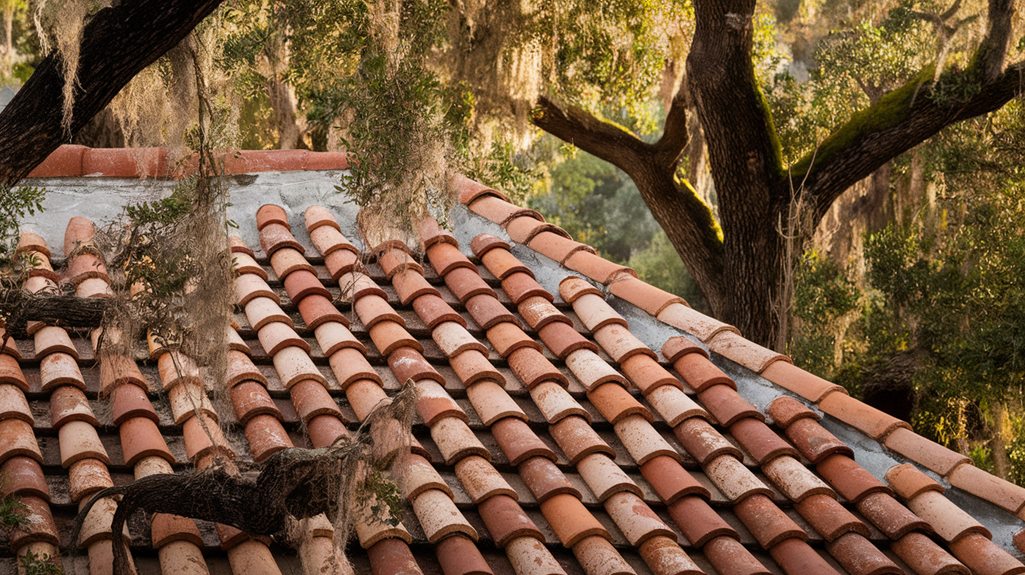
Walnut Hills' historic clay tile roofing necessitates specialized restoration techniques to preserve its architectural character and protect property values. You'll need to collaborate with experienced restoration specialists who grasp the unique challenges of these distinctive Mediterranean-style roofs. Regular inspections can pinpoint cracked, slipped, or damaged tiles before they result in more severe issues.
When you're planning a tile restoration project, you'll find that authentic clay tiles matching the original 1920s designs are still available from select manufacturers. It is crucial to replace damaged tiles with historically accurate materials to uphold the neighborhood's architectural integrity. The restoration process includes delicately removing compromised tiles, repairing the underlying waterproof membrane, and ensuring proper alignment of replacement pieces.
Don't underestimate the significance of maintaining your tile roof's support structure. The weight of clay tiles can strain aging rafters and deck boards, so you'll want your contractor to inspect these components during restoration work. They'll examine the battens, flashings, and ridge caps while ensuring proper ventilation. With proper restoration and maintenance, your Walnut Hills tile roof can continue safeguarding your home for decades to come.
Newly Repaired Spanish Tile Roof
Properly fixed Spanish tile roofs demand special attention during the first few months post-installation. You'll need to closely monitor your recently repaired roof to guarantee the tiles settle correctly and maintain their protective qualities. It's crucial to comprehend that even minor issues during this settling period can result in significant problems later.
Keep track of these vital aspects of your new Spanish tile roof:
- Check for any loose tiles that haven't properly positioned themselves after the repair work
- Monitor the condition of the underlayment, especially following heavy rains or strong winds
- Look for fine cracks that might emerge as the tiles adapt to temperature changes
- Inspect the flashing around chimneys and vents to ensure proper water drainage
- Watch for any signs of moisture in your attic, which could indicate installation issues
You'll want to schedule a professional inspection at least twice during the initial year post-repairs. This helps identify any potential problems early and confirms your warranty requirements. Remember that your recently repaired Spanish tile roof will perform better and last longer when you address minor issues promptly during this crucial settling period.
Slate Roof Cost Comparison
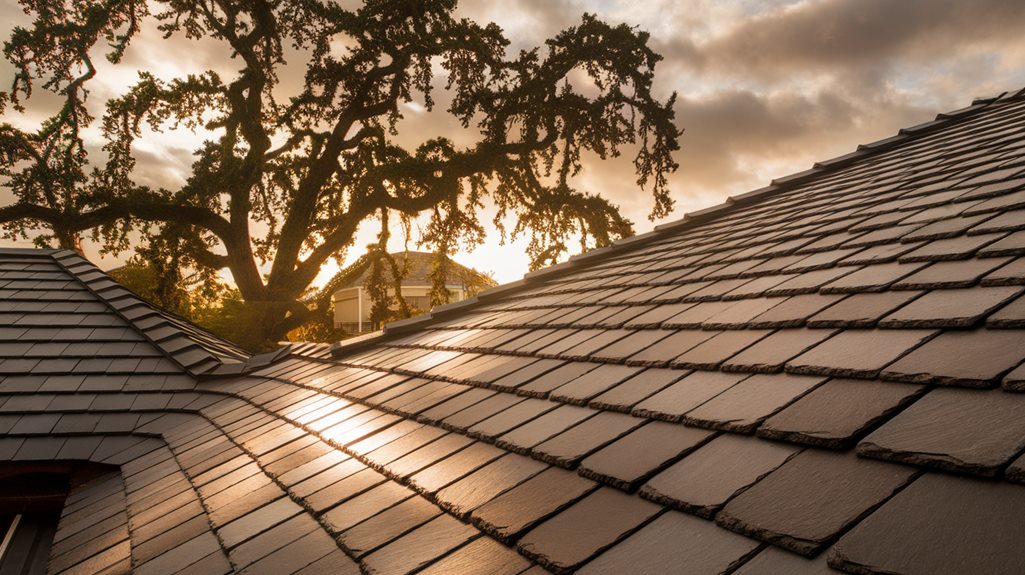
Looking into the costs of slate roofing reveals significant price variations across different manufacturers and grades. You'll find that standard slate tiles typically range from $10 to $30 per square foot, while premium grades can cost up to $40 per square foot. When you factor in professional installation, your total expenses can reach $15 to $45 per square foot.
For your Walnut Creek home, synthetic slate offers a budget-friendly alternative at $7 to $12 per square foot. While it's more affordable, you won't get the same longevity as natural slate, which can last 100+ years compared to synthetic's 20-30 year lifespan. Labor costs in Walnut Creek average $8 to $15 per square foot for slate installation, higher than standard shingle installation due to the material's weight and specialized handling requirements.
You'll need to contemplate additional costs like reinforced roofing structures to support slate's weight, which can add $1,000 to $3,000 to your project. Regular maintenance costs are relatively low, but repairs can be expensive, ranging from $150 to $500 per slate tile replacement, making proper installation essential for long-term cost efficiency.
Protective Annual Roof Inspections
To safeguard your investment in a slate roof or any other roofing material, annual inspections act as your first line of defense against potential problems. You'll want to schedule these inspections during spring or fall when weather conditions are mild and visibility is good. Professional roofers in Walnut Creek can identify early warning signs that might escape an untrained eye.
During your annual roof inspection, professionals will examine:
- Shingle or slate condition, looking for cracks, chips, or missing pieces
- Flashing around chimneys, vents, and valleys for signs of separation or rust
- Gutter systems to confirm proper drainage and attachment
- Underlayment integrity through the attic space
- Signs of moss, algae, or debris accumulation
You shouldn't wait for visible leaks to emerge before arranging an inspection. Water damage often occurs long before you notice interior stains or drips. An annual inspection costs far less than extensive repairs or replacement, especially with high-end materials like slate. If you've recently experienced severe weather or noticed any changes in your roof's appearance, don't hesitate to schedule an additional inspection. Many Walnut Creek roofing companies offer maintenance programs that include regular inspections and minor repairs.
Annual Cost Savings Analysis
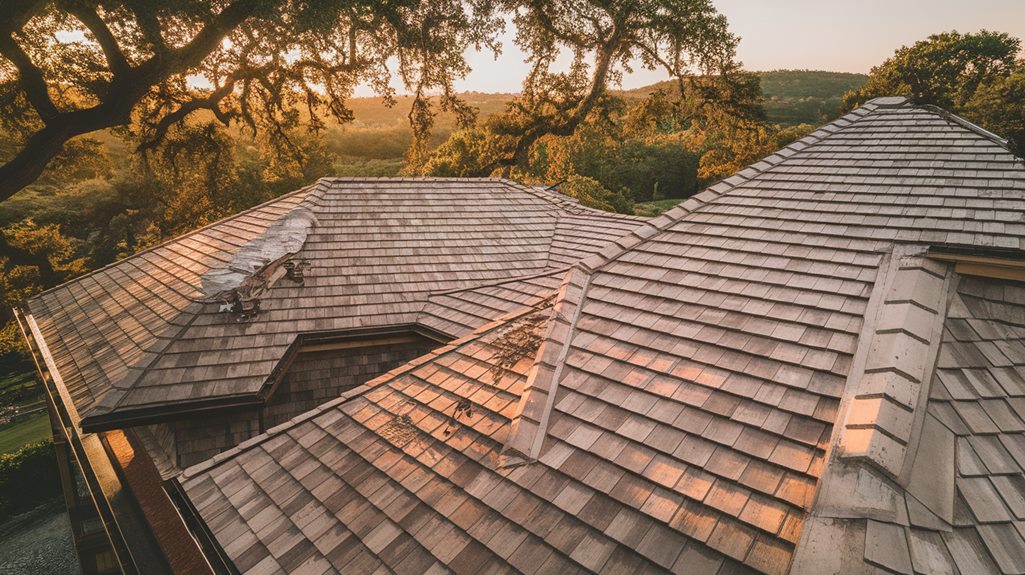
Regular maintenance on your Walnut Creek roof delivers significant financial benefits when compared to reactive repairs. You'll save money through early detection of minor issues that could otherwise develop into costly problems. A typical maintenance program costs between $200-400 annually, while emergency repairs can easily exceed $2,000 per incident.
When you invest in regular maintenance, you'll extend your roof's lifespan by 5-10 years, potentially saving $10,000-15,000 in premature replacement costs. You'll also protect your home's interior from water damage, which can cost thousands to repair. By maintaining your roof's integrity, you'll improve your home's energy efficiency, reducing heating and cooling costs by up to 15%.
Consider that a new roof in Walnut Creek costs between $15,000-25,000. If regular maintenance adds just five years to your roof's life, you're saving $3,000-5,000 annually in deferred replacement costs. You'll also maintain your home's value and curb appeal, which is essential in Walnut Creek's competitive real estate market. Plus, many insurance companies offer reduced premiums for homes with documented maintenance programs, adding to your yearly savings.
Schedule Free Inspection Today
Protection starts with a free detailed roof inspection from our Walnut Creek experts. You'll receive a thorough evaluation that identifies potential issues before they become costly repairs. By scheduling your inspection today, you'll get detailed insights into your roof's current condition and a customized maintenance plan tailored to your home's specific needs.
Don't wait for leaks or visible damage to schedule your inspection. Our certified roofing professionals will:
- Examine all roofing materials for wear, damage, or deterioration
- Check flashings, valleys, and ridges for proper water drainage
- Inspect gutters and downspouts for blockages and proper attachment
- Assess ventilation systems and attic conditions
- Document all findings with photos and provide a detailed report
You can easily schedule your free inspection by calling our office or filling out our online form. Our team will contact you within 24 hours to arrange a convenient time. You'll receive your detailed inspection report the same day, along with clear recommendations and cost estimates if repairs are needed. Take the first step in protecting your home's value by securing your inspection slot today.
Prolong Roof Life, Save Money
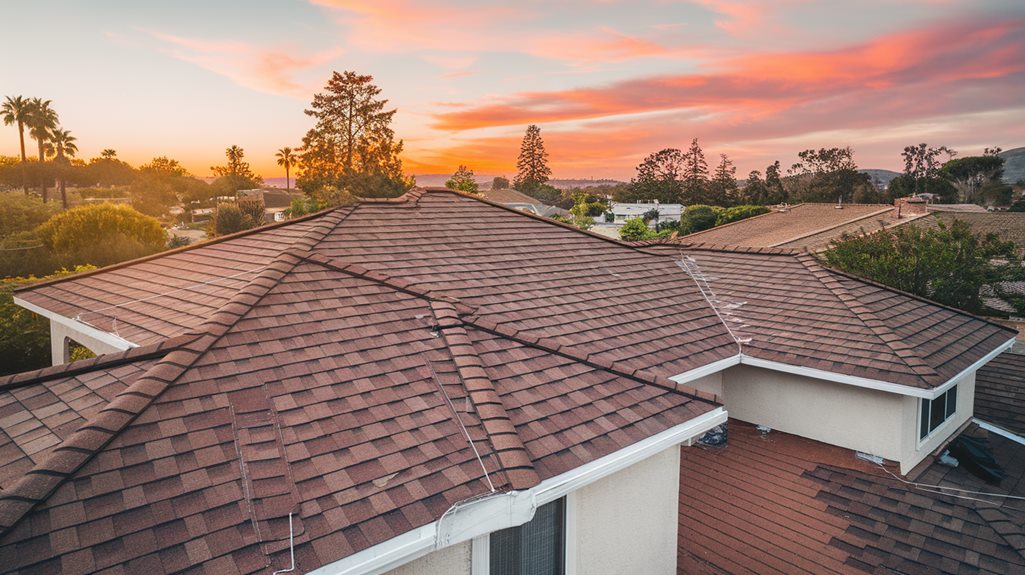
Investing in routine roof maintenance does more than prevent costly repairs – it substantially extends your roof's lifespan and maximizes your investment. By scheduling regular inspections and addressing minor issues promptly, you'll avoid the premature replacement costs that many Walnut Creek homeowners face due to neglect.
Regular maintenance typically costs between $200-500 annually, while a complete roof replacement can run $15,000-25,000. You'll save thousands by identifying and fixing small problems before they escalate into major structural damage. Common maintenance tasks include clearing gutters, removing debris, replacing damaged shingles, and sealing flashings – all of which prevent water damage and extend your roof's durability.
Your roof's lifespan can increase by 10-15 years through proper maintenance. If you've got a 20-year roof warranty, you could potentially extend its life to 30-35 years with consistent care. You'll also maintain your home's value, as a well-maintained roof enhances curb appeal and passes home inspections more easily. Additionally, you'll reduce energy costs since a properly maintained roof provides better insulation and ventilation year-round.
Roofing Warranty Claim Questions
While maintaining your roof can extend its life, understanding your warranty coverage helps protect your investment when issues arise. You'll need to know exactly what your warranty covers and how to properly file a claim if you encounter roofing problems in Walnut Creek's variable climate.
Most manufacturers require specific documentation when you submit a warranty claim. You'll want to keep detailed maintenance records, including photos, receipts, and service dates. It's also essential to understand the difference between material defects and installation errors, as they're often covered under separate warranties.
- Keep your original warranty paperwork and contractor information in a safe, accessible place
- Document all maintenance work with dates, descriptions, and photos
- Report damage promptly – most warranties have strict time limits for filing claims
- Understand what voids your warranty, such as DIY repairs or unauthorized modifications
- Maintain proof of professional inspections and repairs throughout your warranty period
If you're unsure about your warranty coverage, contact your roofing contractor or manufacturer directly. They can clarify specific terms and guide you through the claim process if needed.
Walnut Creek Building Department
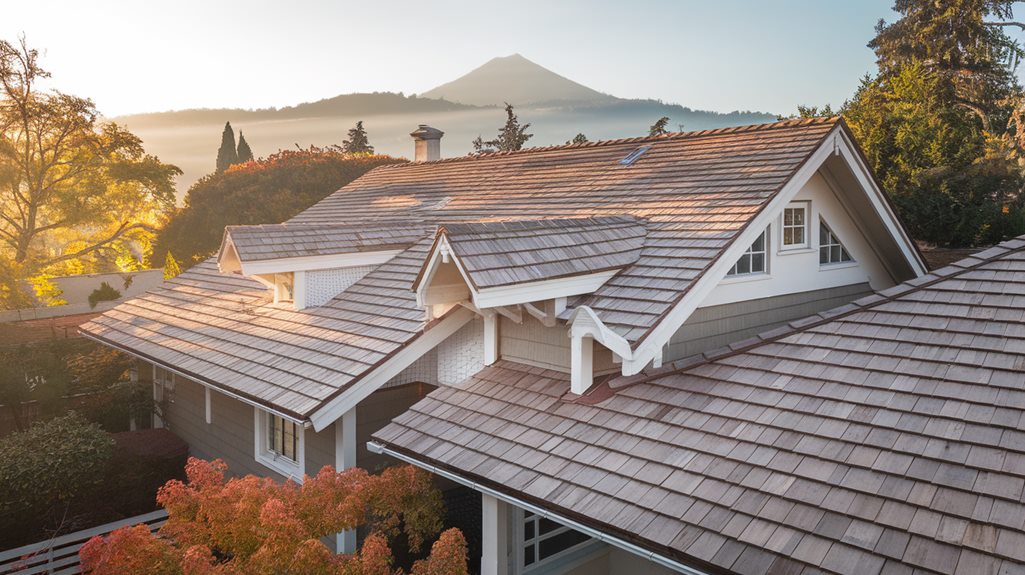
Local building codes and permits through the Walnut Creek Building Department play a critical role in your roofing project's success. You'll need to obtain proper permits before starting any major roof repairs or replacements in Walnut Creek. The department makes sure your roofing work meets California's strict building standards and local regulations for safety and durability.
To get your permit, you'll need to submit detailed plans and specifications to the Building Department, located at 1666 N. Main Street. They require information about your roofing materials, structural modifications, and contractor's license. You can apply online through the city's permit portal or visit the office in person during business hours, Monday through Thursday.
Don't skip the inspection process – it's mandatory. The Building Department will conduct multiple inspections throughout your project, including a pre-roofing inspection and final inspection. You'll need to schedule these inspections at specific stages of the work. If you're working with a contractor, they should handle the permit process and coordinate inspections, but it's your duty to verify they've obtained all necessary approvals. Keep copies of all permits and inspection reports for your records and future warranty claims.
Conclusion
Just like a neglected houseplant wilts and dies, your roof needs consistent care to thrive. You wouldn't ignore a leaky faucet for years, so don't overlook your roof's maintenance needs. With proper care, you'll extend your roof's life by 40% and protect your home's value. Don't wait until it's too late – schedule your free inspection today and keep your Walnut Creek roof sheltering you for decades to come.

